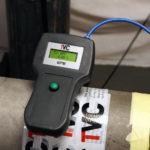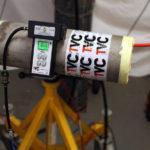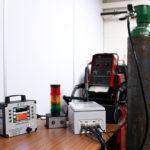Types of O2 Sensors
For many years, the welding industry has used simple handheld meters to measure the level of O2 in inert gas used for the back purging of pipes and vessels prior to and during welding. The cheapest and simplest sensor type was always the chemical cell. However, new O2 sensors have been developed in recent years that offer increased accuracy, repeatability, and sensor life span.
Chemical Cell O2 Sensors
Chemical O2 Cell Sensor technology has existed for 30 to 40 years. Due to their low cost, robustness, simplicity of use, and low current consumption, they are ideal for simple, battery-powered handheld O2 purge monitors.
However, as a result of oxygen exposure, chemical cell sensors deplete their chemical elements. Over time the chemical element reduces in the cell until it no longer functions and must be replaced. In most commercially available cells, this can take anywhere from 6 to 18 months, depending on the construction and amount of oxygen it is exposed to. The cheaper chemical cells tend to have a repeatability of up to +/- 350ppm (+/- 0.0350%) due to the continuously depleting chemical element that, as it depletes, changes the sensor’s voltage output. Therefore, they must be adjusted continuously by comparing them to a known O2 level. As normal atmospheric conditions have a known O2 level of approximately 20.9%, we can simply use this as the reference to adjust the sensor as necessary.
Compromised Accuracy
In the case of measuring very low oxygen levels, i.e., below 1000ppm (0.1%), there is a limitation to this. At low Oxygen levels, the accuracy depends entirely on the accuracy of the adjustment made at atmospheric conditions, so, for example, if 20.8% is set, then the unit could read 0 ppm at anything below 1350 ppm when offsets and sensor accuracy at +/-350 ppm are taken into account. A number of the latest models have automatic calibration adjustments based on atmospheric conditions, which greatly reduces the risk of this issue occurring. This again does not take into account any changes in oxygen levels due to barometric conditions, so accuracy is compromised.
The Advantages of Optical O2 Sensors
The medical industry has had optical sensors for measuring oxygen for a longer time than the welding industry, but sensors using this technology are now available at prices that make them more affordable and useful for welding O2 purge measurement.
Optical sensors used by TVC in their BPM and HPM handheld purge monitors offer far more benefits to chemical cells. Optical cells are comparable to chemical cells in price and power consumption, but optical cells have a repeatability of +/- 100ppm and can resolve down to 100ppm O2 levels. In addition to the onboard pressure sensor, optical cells are capable of automatically correcting for barometric pressure as well. Finally, they do not deplete and, with only a yearly recalibration, optical sensors should last for several years, thereby reducing ownership costs over time compared with chemical cells.
Higher Accuracy Using Hybrid Dual Sensor Technology
Where higher accuracy is required at lower oxygen levels, TVC uses Zirconia sensor technology. In combination with an optical sensor, the Zirconia sensor provides an O2 measurement range from 22% right down to 1ppm. Historically, Zirconia sensors have been typically large or power-hungry due to their need to heat up the gas under test to between 500ºC and 800ºC. Due to this, power-hungry heating elements are used, drawing up to 4 amps, therefore making the sensors unsuitable for battery-powered handheld equipment.
TVC has developed a hybrid dual optical Zirconia sensor for the GPM and HPM-02 units that allow an incredibly small, low-power Zirconia sensor to measure from 1000ppm to 0ppm in 1ppm steps, while the optical O2 sensor can measure up to atmosphere 02 levels of 21%.
Less than twice the size of a conventional chemical O2 cell, the TVC dual sensor module is exceptionally compact. TVC HPM-02 and GPM units are extremely competitive on price with far greater resolution and accuracy than chemical cells.
From Handheld Spot Checks to Comprehensive Purge Monitoring Systems
Basic Purge Monitor BPM
The BPM unit is a basic purge monitor capable of measuring to down to 100ppm with repeatability of +/-100 ppm. Featuring simple and easy single-button operation, it provides quick spot checks of O2 levels with low operating costs at an affordable price.
Hand-held Purge Monitor HPM
HPM-01 and HPM-02 units offer onboard data logging, programmable high/low limits, and a simple, easy-to-read ‘Traffic Light’ colour-changing display if lower O2 levels or greater accuracy are required.
A new development for the HPM units for 2021 is the addition of a Dew Point sensor option. In addition to measuring O2 levels, the HPM can also measure the gas Dew Point from -8°C to -60°C. As with the BPM, the HPM units are very competitively priced with low running costs.
Gas Purge Monitor GPM
Compared to handheld equipment, the GPM offers a multitude of additional features for semi-permanent and permanent installations. Installations that are robotic or automated can also benefit from its use. Mains powered, the unit uses Hybrid Dual Sensor technology, and has a large OLED colour screen. It features the same ‘Traffic Light’ colour-changing display function with programmable high/low limits as the HPM units. The GPM also features onboard data logging and options for:
- External Traffic Light Warning Beacon with Audible alarm
- 3-stage remote gas flow control
- Auto Start/Stop functionality and control for Robotic and Automated installations
- Gas Dew Point/Moisture sensing
- Remote wireless operation for Pipeline tie-in welding of up to 2 Kilometres and a proportional output
Universal Functionality
Both the GPM and HPM units have digital outputs which can be connected directly to TVC weld data logging systems or, if required, customers’ own monitoring equipment.
For further information on the range of TVC Purge Monitoring and Gas Monitoring equipment please contact TVC or one of our authorised Sales Distributors.



